2024 Fantasy Football Rankings ... With Rookies!
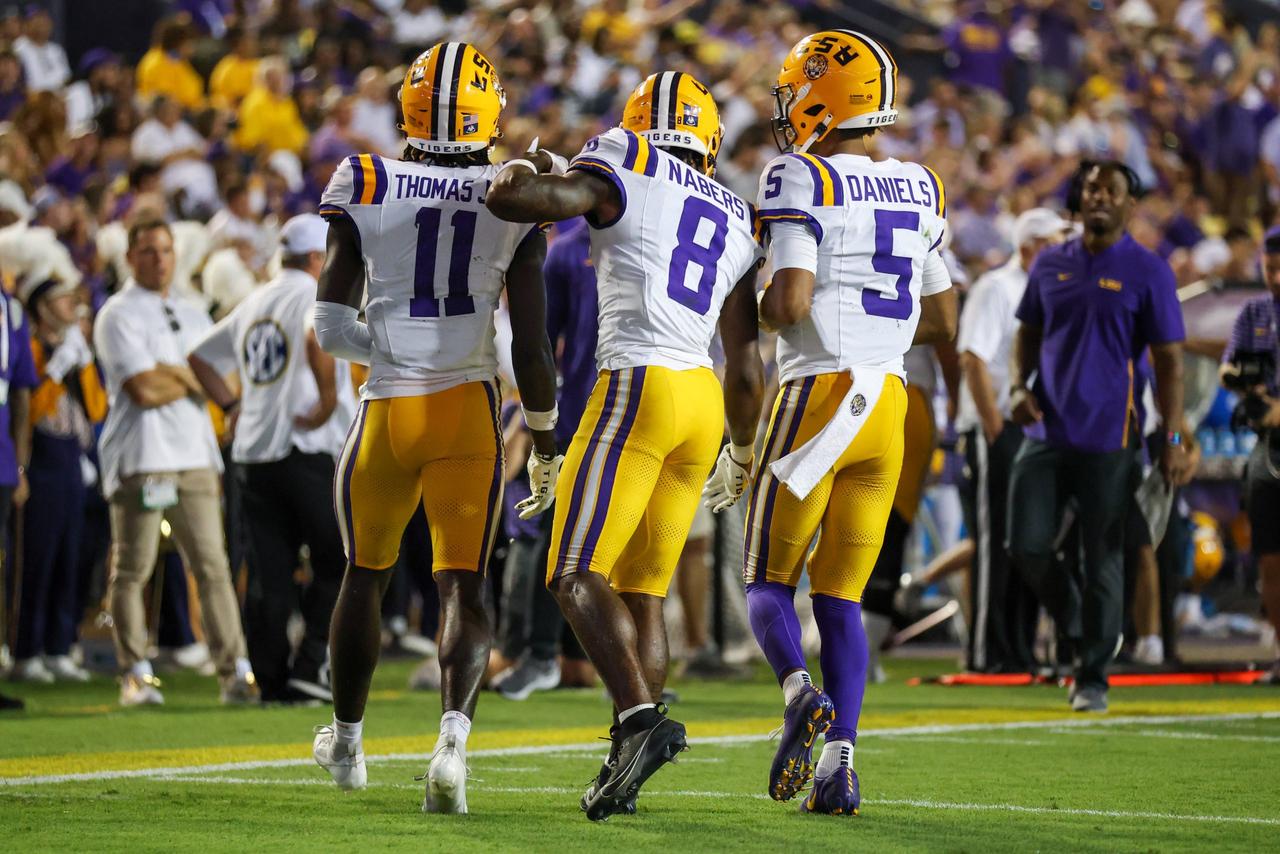
With the Chiefs winning yet another Super Bowl, it's time to update my 2024 fantasy football rankings with notes on the upcoming rookie class. In general, this is a great class for the dynasty streets with the potential for 4 QBs, 3 WRs, and a TE to go within the first 12 picks in the 2024 NFL Draft. Things are subject to change after the Combine, after I run my draft models, and after circling back to the tape for a second watch, but I've ranked and graded the prospects I've watched. Expect 50ish videos to pop up on YouTube. Welcome to draft szn.
2024 Fantasy Football Rankings
Way Too Early Rookie Rankings & Grades
QB1 Caleb Williams (Grade: 1st Overall Pick) - Since giving out prospect grades in 2020, I've had five 1st overall pick grades. They are Joe Burrow, Trevor Lawrence, Justin Fields, C.J. Stroud, and now Caleb. I'd take him over all of them because none have had his combination of arm talent, play-making ability, and feel for the game. Williams had 92nd percentile passing and 93rd percentile rushing EPA as a true sophomore, then he dipped to the 80th percentile in QB rating with a worse supporting cast in his final season at USC. As a Trojan alum, the entire season was a waste and beyond frustrating. The OL was the worst of the top QB prospects, his perimeter talent was average at best, and the defense had Alex Grinch at coordinator. Perhaps more maddening than all was the wasted plays. For example, Williams threw by far the most screens in the Power 5 (137), yet they had a 34% success rate and 6.0 yards per attempt. Maddening!
As for his own traits, Williams' pocket navigation and ability to find a throwing window while working to his left or right is unbelievable. He routinely steps up in the pocket, escapes free rushers to the boundary, and can take a hit inside the pocket to get to a backside read. The entire playbook is available. Williams had a lot of quick-game throws in USC's air raid offense as a version of a "run game", but his raw arm strength is one of his top traits. He can throw it 65 yards with his feet set or on the run with both accuracy and velocity. He also averaged +0.45 EPA per play on scrambles and broken plays because of his rushing athleticism. Only so many people on the planet can do all that at his level.
Williams' feel for the game, anticipation, and ability to get through progressions goes overlooked because of his wow moments. Williams had +0.54 EPA per play on the classic timing routes (slants, comebacks, curls, digs, outs) from inside the pocket because he's a twitchy thrower and has great knowledge of defenses. He threw an above average amount of hitch routes with great success, largely because of his pre-snap reads. He also threw with the correct trajectory based on defensive alignments when scrambling around.
For as often as he was forced to make a play, Williams' 1% interception rate is remarkable. His 5 INTs included a 50/50 ball (bad WR play), a miscommunication by a WR, an overthrown RPO against a free rusher, and then two dangerous throws out of structure. His 16 "fumbles" included 5 that were completely his fault, 4 strip sacks, 3 mesh points on zone reads with the RB, 3 bad snaps, and 1 dropped snap that turned into a 76-yard passing touchdown. You can make a negative play compilation for clout, but Williams is actually careful with the ball for how much he had to do.
Cleaning up some of the unforced errors is an obvious room for an improvement, but where Williams does need to actually improve is by staying consistent with his feet. There were times where he'd rely on his freakish arm talent rather than setting his feet, leading to some erratic throws. At times, he felt frustrated or bored. As we've seen with Patrick Mahomes, Williams will have to evolve over time. I believe he'll be able to because it's clear he loves ball, puts in the work, and has time to develop. After all, he'll be 22 years old during most of his rookie season.
QB2 Drake Maye (Early Round 1) - With a better supporting cast in 2022, Maye led college football in total EPA (+115.4), but things regressed as a junior in a sub-par environment. His final season fell into the 78th percentile in QBR, 66th percentile in EPA per play, 93rd percentile in rushing EPA, and 48th percentile in passing EPA, so Maye's profile definitely requires projection. The good news is he's a toolsy player with ideal size, arm talent, and athletic ability. He doesn't touch Josh Allen in any of those categories, but he's not far off either. Like Allen, there are some questionable decisions sprinkled throughout his tape, likely because he's so young. If things click moving forward, Maye has borderline top 5 QB potential in the tier of Dak Prescott, Trevor Lawrence, CJ Stroud, Matthew Stafford, and Jalen Hurts.
Maye has flashed the ability to make every throw, basically only out of shotgun. He has the arm strength for go balls, sideline throws, and tight window passes over the middle of the field. He also can throw on the run, to both sides because he's a physically strong athlete. On occasion, Maye can layer in throws, though that's far more of a work in progress. His feet can heel click and his base can squat up and down too much, leading to inaccurate passes. Maye's 71% catchable ball rate on clean passes 15+ yards downfield is definitely below average, and his EPA generated on the classic timing routes underneath was the worst of the consensus top prospects:
What's frustrating is he actually does throw with anticipation and does attack the middle of the field. Per SIS, 10% of Maye's passes were digs or crossing routes over the middle. That only trails J.J. McCarthy and generally is a high mark. He can make those throws because he's tall (vision line matters) and is willing to take a hit in the pocket while the backside route develops. Maye simply has to just be more accurate to have these Matthew Stafford like throws be a staple of his game. That said, Maye does hold onto the ball a little longer than needed at times, leading to some iffy sacks. His 20% pressure-to-sack rate is a little worrisome, and PFF credited Maye with 26% of the responsibility that there was pressure. The latter was 7th worst out of 71 Power 5 qualifiers. Compared to drafted QBs since 2000, Maye's EPA lost due to sacks is in the 25th percentile. Once again, supporting cast and being young are factors.
While his feet, accuracy, and pocket awareness improve with more experience, Maye has a fantastic trait to fall back to: scrambling. He's finished 1st and 4th in first downs on scrambles in all of college football over the last two seasons. Last year's 52% first down rate on his scrambles was 2nd best, too, so he's not doing it recklessly. Maye has feel for when to take off and the athletic traits to finish off runs. Overall, there are similarities to Anthony Richardson's profile as a prospect in development with all the tools to believe in. He needs more coaching. He needs more live reps. But there are too many high flashes of NFL throws and runs to not be enamored with the upside. And for his collegiate flaws, Maye certainly made a lot of full-field reads and wow plays with his legs.
QB3 Jayden Daniels (Early Round 1) - This is a very tricky evaluation because Daniels only trailed Joe Burrow in total EPA among all drafted QBs since 2000, and his +0.26 EPA per play is the best of all time. LSU afforded him two elite vertical WRs and a quality OL, but Daniels made a ton of plays himself. For example, Daniels' final season rushing EPA only trails Lamar Jackson, Cam Newton, and Malik Willis. His raw speed belongs in the L-Jax conversation, but can that translate at likely under 200 pounds? I wish he ducked some of these hits outside the pocket as well as he ducked weighing in at the NFL Combine. His "Johnny Knoxville" comparison was made for a reason.
Assuming he'll slide more than he did in college, the designed run game will be a factor in the NFL, and Daniels' scramble production is off the charts. His +0.63 EPA average on 154 reps with a scramble or broken play blows out everyone. It's an uncoachable trait that's difficult to find. Daniels did sacrifice some potential second-level throws at the top of his drop to make these scrambles happen, however. His eyes would often get to the right spot. He just wouldn't pull the trigger on some throws. That has to improve, which is a concern given his age (turns 24 years old next December).
Daniels is an accurate thrower to all levels. He led the class in catchable rate on throws 15+ air yards downfield without pressure, per Sports Info Solutions. Many of those downfield shots were wide open because Malik Nabers and Brian Thomas, but Daniels can throw the slot fade, corner route, and go ball with nice loft. If he has to squeeze a ball in over the middle, he can throw it with velocity, too. In general, Daniels has quality arm talent. There are pre-snap anticipation throws. There are also backside reads after post-snap rotations against SEC competition. Like mentioned above, he wouldn't pull the trigger at the top of his drop routinely, and only 22% of his throws were over the middle. Some of this was his own indecision. Some of this was because the slot fade or perimeter go ball were too deadly to not "one read" things.
Ultimately, there are unteachable traits to work with, and Daniels' production is off the charts. Some of it will not translate for size and matchup reasons. It didn't with RGIII and hasn't so far with Bryce Young, for example. That said, there should be some very fun upside games because he has solid arm talent to pair with his elite speed. I'm just worried about the consistency of it when there aren't such obvious perimeter advantages. He's a classic boom-bust outlier prospect.
QB4 J.J. McCarthy (Mid Round 1) - Michigan led at halftime in every game (average +13.2 point lead), so McCarthy only threw 22 passes per game as a true junior during their undefeated National Championship run. Typically that's a very bad sign, but Jim Harbaugh did the same with Andrew Luck at Stanford and more importantly, McCarthy was efficient when asked to throw. His EPA per play (93rd percentile), QB rating (95th percentile), and rushing EPA (63rd percentile) were well above average among drafted QBs since 2000.
His evaluation is complex because McCarthy was arguably the worst of the top-6 QBs based on his 2023 tape, but he also was 20 years old. His body is simply not fully developed yet. McCarthy is a very lose athlete with plenty of line-drive arm strength, even on the move, but he needs to get stronger. There were deep passes that died out. There were also missed sideline throws because he was really stepping into things, causing the lowest on-target rate on sideline throws with 10+ air yards of the top prospects. While concerning, human biology suggests those problems will age out once he adds 10-20 pounds to his frame in the NFL. If arm strength (and the footwork/accuracy attached to it) is his biggest flaw, there's at least hope it gets fixed over time. After all, McCarthy was a 5-star recruit out of the IMG Academy. There's a strong athlete in there waiting to be developed.
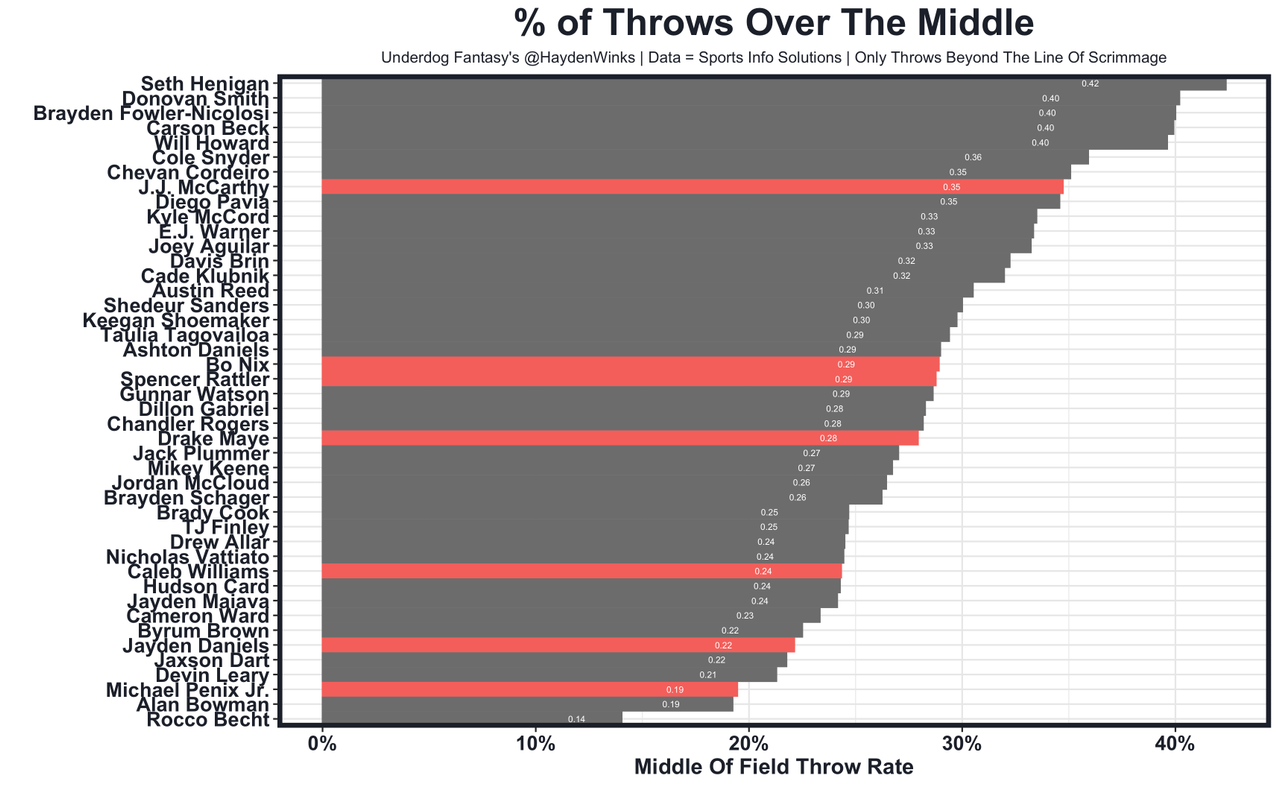
The Wolverines did put McCarthy into some tough 3rd-and-long situations because of their early-run tendencies, and he delivered. In fact, his 10.9 YPA on 3rd-and-6 plus attempts led the class. For someone so young, McCarthy was impressive working the middle of the field. He led the class with 35% of his throws going over the middle and actually had the most raw middle attempts on digs and crossers (45) by far, despite having fewer dropbacks in total. These anticipation throws, sometimes coming from the under-center play action game, are what makes him a potential fit for the growing number of Shanahan tree teams. Early in his career, expect McCarthy to stay within himself and continuously throw within 20 yards of the line of scrimmage. His EPA per play on the classic timing routes (slants, comebacks, curls, digs, and outs) was the best in the class last year. He can reliably play on time, even if the go ball is a rarity.
McCarthy can feel pressure coming and is willing to take a hit in the pocket, but his ability to throw on the run and scramble are what could set him apart from the other Shanahan tree QBs. He averaged +0.32 EPA on scrambles or broken plays (3rd best) and can make tight-window throws when running to his right. That could be a nice combination in the play action bootleg world. His speed isn't even "sneaky athlete" level. He's actually fast. There were some QB designed runs and he took off for impressive scrambles when things got a little panicked in the pocket. It takes projection to see the vision, but McCarthy checks a lot of the boxes for the modern NFL, especially if he gets a half or full year on the bench to develop. Don't be surprised if he's a top-12 overall pick.
QB5 Bo Nix (Late Round 1) - He's played 4,032 collegiate offensive snaps across five seasons and two universities. His Auburn days were a struggle, but Nix scored 95 total TDs in his final two years with Oregon. During his senior year, Nix had 97th percentile EPA per play, 93rd percentile passing EPA, 63rd percentile rushing EPA, and the best sack avoidance EPA among all drafted QBs since 2000. That said, 21% of his passes were RPOs, 32% were behind the line of scrimmage, 40% were play action, and 88% were without pressure because he played behind one of the best offensive lines in college football. In other words, some of his production was scheme and talent related.
Many people assume his profile stops there, but I thought he played well in "normal situations". He was 1st in PFF passing grade, 1st in turnover worthy play rate, 2nd in EPA, and 2nd in success rate when removing his screen and RPO attempts. On tape, Nix played in rhythm, often taking the easier throw to continue moving the chains. There's a poor man's Burrow style to his game. He has average size (6'2"/217) and slightly above average athleticism. There were plenty of throws on the run, and he's accurate while doing so. Per Sports Info Solutions, Nix led the consensus top-6 QBs in on-target rate on passes 10+ air yards and near the sideline (60%) because he can throw with touch and arc.
His arm strength is average in every way, as he rarely wows with velocity yet rarely under-throws receivers, but he at least threatens all levels of the field and can find an unnatural arm angle when necessary. Where he gets in trouble most is when the pocket collapses up the middle, leading to some very puzzling footwork and errant throws. Nix faced pressure on just 16% of his dropbacks per PFF, so his feet could be a bigger issue in the pros when things get tighter. It's his biggest flaw on tape at this point and likely can't be fixed given his age (24).
Where Nix is underrated is as a runner. Oregon designed some zone read, QB power, and draws to take advantage of his sneaky athleticism. He meets the playmaker threshold for today's NFL (even if his physical traits are likely to be capped outside the top-10 discussion) and he literally had three (3!!!) real sacks in 2023. His ability to limit negative plays while picking up a few plays on his own makes me believe in him as an average to low-end NFL starter.
QB6 Michael Penix (Late Round 2) - Assuming his knee surgeries aren't cause for worry, Penix (6'3"/213) is a classic in-pocket QB with a live arm and questionable play-making ability. In fact, his 88% in-pocket rate was the highest of the class and he used a 3-step drop out of shotgun on more than half of his dropbacks. Washington afforded him the best OL in the country and he legitimately had a better WR trio than some NFL teams (I'm talking to you, New England), so it's not overly surprising to see his stats look pristine. His EPA per play, total passing EPA, and QB Rating were all in the 83rd percentile among draft QBs since 2000.
On tape, Penix throws the ball with high-end velocity and did so constantly in OC Ryan Grubb's aerial offense. He can throw to the sideline and deep downfield but does so on a rope, rather than playing with touch. His arm strength, even at some awkward angles like throwing left as a lefty thrower, is fantastic and Washington fully leaned into it. Penix led college football in back shoulder, corner, seam, go, wheel, or double-move throws (125 per Sports Info Solutions). Those are all deep tosses into open windows often near the sideline. There are times where his feet can get static and parallel with the line of scrimmage, leading to spraying footballs. There are also times where he was a tad late to the throw, forcing a lower-probability max velocity attempt into a tight window. More often, throws over the middle were batted down because of a lack of arc ... It's hard to really move the needle when his plays with either a broken play or a scramble resulted in -0.17 EPA per play, the worst of the group by a wide margin. Penix has troubling splits as a thrower while facing pressure, where his adjusted completion percentage dipped from 78% to 58% and his first down rate dropped from 45% to 23%. That said, he at least doesn't let the pressure turn into a true negative play because he has a nice feel for incoming pressure. Statistically, his 7.6% pressure to sack ratio is fantastic and his -6.9 EPA lost to sacks is in the 91st percentile among drafted QBs. That sack-avoidance trait is often undervalued and keeps him afloat as a high-end backup, even if he's not creating himself.
In general, Penix made a ton of distance throws in college, but his touch and footwork are inconsistent and he's not a play maker outside of the pocket. Based on his age (24) and injury history (2 ACLs and 2 shoulders), Penix could have a similar NFL Draft night as Hendon Hooker, who went in Round 3. I liked Hooker's tape more personally because he was a better athlete with better touch on his throws. I compare Penix to what the Geno Smith haters think Geno Smith is ... but as a lefty.
TE1 Brock Bowers (Mid Round 1) - Possibly a top-5 overall selection, Bowers has rare athleticism and production out of Georgia. The offense made him the focal point, particularly in the screen game and out in the flats where his rare yards after the catch ability shines. He can break tackles and straight up avoid them altogether. Bowers is physical for a player with his finesse and lack of size, meaning he'll play on almost all downs. There is 100-catch season potential as OC's will manufacture easy receptions to take advantage of his agility and speed. While both are phenomenal prospects, Bowers and Kyle Pitts basically don't play the same position. Pitts was a downfield target. Bowers, underneath and over the middle. As a blocker, Bowers is average with room for growth as he puts on more mass.
TE2 Ja'Tavion Sanders (Round 3) - A traditional inline TE out of Texans, Sanders made some wow catches in contested situations primarily from a one-point stance. He ran most of his routes up the seam or on crossers, rather than being utilized in the screen game or out in the flats. He has big-play athleticism after the catch once his speed is built up. Sanders is a bit raw in general but had two very productive seasons before declaring early. He seems like a 2nd rounder and rookie starter.
I need to watch 94th-percentile athlete Theo Johnson out of Penn State.
WR1 Marvin Harrison (Early Round 1) - It'd be a shorter preview if I listed the things Harrison isn't awesome at. He's just fine after the catch (5 missed tackles), with less agility than other All Pro WRs ... That's basically it. The Patriots (3rd overall), Cardinals (4th), or Chargers (5th) are getting a physical X receiver (80% outside) with more size (6'4"/205) than his Hall Of Fame father. Junior is a patient route runner against press man coverage with the burst to create separation downfield and at the break point, but he can also win with an "and one" mentality when needed. His ball tracking and size make him a Day 1 big play threat, while his mature tempo makes him a candidate for an annual 75-100 receptions. It's close to the total package, a la A.J. Green.
WR2 Malik Nabers (Early Round 1) - He's outrageously explosive, in the tier of Ja'Marr Chase and Jaylen Waddle on tape. Nabers was utilized inside (54%) and out (46%), and short and deep (12.2 aDOT). He bounces off defenders after the catch but more importantly has the burst to run right by them. Nabers, only 20 years old on draft night, has room to develop at the line of scrimmage because he's a bit smaller than other true No. 1 WRs, but physicality isn't an issue for him in general. While in the route, Nabers already uses tempo and body control to create separation, on top of being a straight-up better athlete. They used him on slot fades, go balls, posts, and corners most often, but anything underneath is well in his bag. He posted a 89-1,568-14 receiving line against SEC competition, and nobody in the class had a better yards per route (3.6) and first down per route rate (16%) than Nabers. His comparison is Ja'Marr Chase.
WR3 Rome Odunze (Early Round 1) - He's a highly productive outside WR from Washington, who has the size (6'3"/212) and athletic profile (59th percentile adjusted SPARQ) of a top target in the NFL. Odunze is very tough, making him a menace at the catch point in contested situations (75% in 2023 per PFF). He won repeatedly on slot fades and with double moves from the perimeter to set up jump balls. He didn't look like an elite speedster (4.47 forty) and was quite reliant on these jump balls to create splash plays, but Odunze can play with tempo and bend his hips (93rd percentile short shuttle) allowing him to run a full route tree. His senior year declare status combined with his "regressable" contested catch rate are reasons for some pause, but I'm not overthinking this. He'll be a top-9 selections, perhaps as high as 6th overall to the Giants. DeAndre Hopkins, Dez Bryant, Alshon Jeffery, Courtland Sutton, and Kenny Golladay are comparable players.
WR4 Brian Thomas Jr. (Mid Round 1) - He's a vertical WR with more size (6'3"/209) than most of this downfield profile. His 4.34 speed translated to a 95th percentile speed score, and boy does it translate to the tape. Thomas had plenty of yards after the catch reps underneath on hitch routes (42% of his targets) where he showed off some stop-start ability, but his calling card is winning downfield with burst or size. He caught 15-of-22 targets with 20+ air yards for 12 touchdowns and a blistering 670 yards (30.4 YPT!!!). Unlike other deep threats, Thomas has X receiver traits because he can bend at the top of his route and physically fight off press man coverage. Only four of his receptions came behind the line of scrimmage, meaning his elite 19.9 half PPR points per game as a true junior were all very real reps. Even though he wasn't LSU's No. 1 receiver next to Malik Nabers, Thomas can be just that in the NFL. Amari Cooper, Braylon Edwards, Sammy Watkins, Martavis Bryant, and Devante Parker come up as statistical comparisons.
WR5 Adonai Mitchell (Late Round 1) - He was able to do a lot of different things at Texas, including an enormous compilation of double moves and go balls (16.0 aDOT). Mitchell slipped at the top of his routes more than I'd like on breaking routes, but he is a lengthy (6'2.5"/205) prospect with quality ball tracking, reliable hands, and 4.34 speed. Mitchell had 97th percentile adjusted SPARQ athleticism at the Combine, while opting out of the agilities. He can use that straight-line burst out of the break when he's balanced, but his yards after the catch numbers are well below average (3.2 yards per catch) and his bend was inconsistent at the break point. He's complicated because when he's under control, he looks awesome. Real awesome. I just didn't see that routinely, which explains his inconsistent production profile. He had a well below average 1.7 yards per route run and 9% first down per route rate in a competitive Texas offense, leading to 12.7 half PPR points per game as a true junior. In general, Mitchell has the physical traits to be groomed into a potential No. 1 receiver over time, and at the very worst, he has the size/speed profile of a quality deep threat. The statistical comparisons range from Justin Jefferson (far more bendy) to Sammy Watkins, Torrey Smith, Martavis Bryant, and Breshad Perriman. The profile is somewhat similar to George Pickens, too.
WR6 Ladd McConkey (Late Round 1) - He's not just a slot WR. McConkey constantly won on the perimeter, on intermediate and deep routes, and played with a lot of physicality at Georgia. The injuries combined with his size (5'11.5"/186) could hold him out of Round 1, but McConkey does everything that a 80-reception WR in the NFL does. His yards after catch on screens caught defenders by surprise (4.39 speed) and he consistently wins on double moves, posts, and go balls because Ladd McConkey will route you the eff up with tempo, head movement, and knee bend. Statistically, McConkey didn't produce like the elites (11.2 half PPR per game in last two seasons) while operating as the No. 2 target next to Brock Bowers in Georgia's run-heavy offense. In fact, he only had two games above 20 routes as a Senior, but McConkey was an efficiency outlier. He led the Power 5 in EPA per route (+0.30) and individual points earned per route (+0.17) per Sports Info Solutions, and he was the WR2 in success rate on his targets (70%). McConkey has similar Combine measurables to Garrett Wilson, Chris Olave, Calvin Ridley, Emmanuel Sanders, Greg Jennings, Santonio Holmes, Rashod Bateman, and Jayden Reed.
WR7 Xavier Worthy (Early Round 2) - A record-setting 40-yard dash (4.21 seconds) will live with Worthy's profile for eternity and likely pushes him into the Round 1 discussion, despite weighing 165 pounds. Very, very few players at that size have been high-volume WRs even if they run like the wind, but the NFL is changing. Worthy can be used on "cheat motions", in the slot (40% of his snaps), in the screen game (21% of his targets), or in bunched sets if his size does work against him at the line of scrimmage. That wasn't much of a problem in college because corners were respecting his deep speed at truly hilarious levels, but it's worth noting that 39% of his 75 receptions came behind the line of scrimmage because Texas threw so many screens to him. ... Down the field, Worthy can cut off his deep routes on a dime. He obviously can run past defenders, too. His primary weak spot is at the catch point, and it was a very real problem. He caught just 5-of-21 contested opportunities, sometimes not being big enough in jump ball situations downfield and sometimes allowing CBs to reach through him on shallower routes. That likely can't be fixed given his petite frame, and it could prevent him from being a 120-target player. There were also some reps where he took the play off or his ball tracking lapsed. Ultimately, his 0.05 EPA per route and 51% target success removing screens are among the worst in the class. Quinn Ewers' inaccuracies and these negative traits explain his just fine junior production (12.3 half PPR per game) and 6-of-23 deep target catch rate. ... He will still be a threat off play action, similar to rookie-year Tank Dell, because he can tempo his routes. Worthy's early-age production (led Texas in receiving as a freshman, sophomore, and junior) separates him from the John Ross bucket, and his route nuance separates him from Tutu Atwell, Marvin Mims, and Anthony Schwartz tier. The NFL Draft throws out failed DeSean Jackson comparisons annually, but Worthy's odds of turning into D-Jax are higher than most. He could bring the Tyreek Hill element to the Chiefs offense again, even if Hill was far more physical. His most likely outcome is being in the Jameson Williams and Tank Dell conversation as a dangerous No. 2 receiver.
WR8 Keon Coleman (Early Round 2) - It was a collegiate career filled with what ifs and poor QB play, but Coleman at least has the size and big catch ability to suggest there's an upside to chase. Coleman wins on jump fades in the red zone, double moves on the perimeter, and in contested catch situations over the middle. He just didn't showcase the rest of the route tree during his time at Michigan State and Florida State, though I do think he has the requisite knee bend and hand confidence in route to do it more if asked. In general, Coleman's ball skills were so good that the FSU system would force impossible targets in traffic, inflating his rate of contested catches (which some are holding against him). If he's better than expected on slants and digs, then we have a George Pickens type of player with a little less speed and a little more agility. His 1.7 yards per route run and 7% first down per route rate suggest the odds are slightly against him, but he had plenty of touch competition (see: RB Trey Benson, WR Johnny Wilson, TE Jaheim Bell, and QB Jordan Travis rushing).
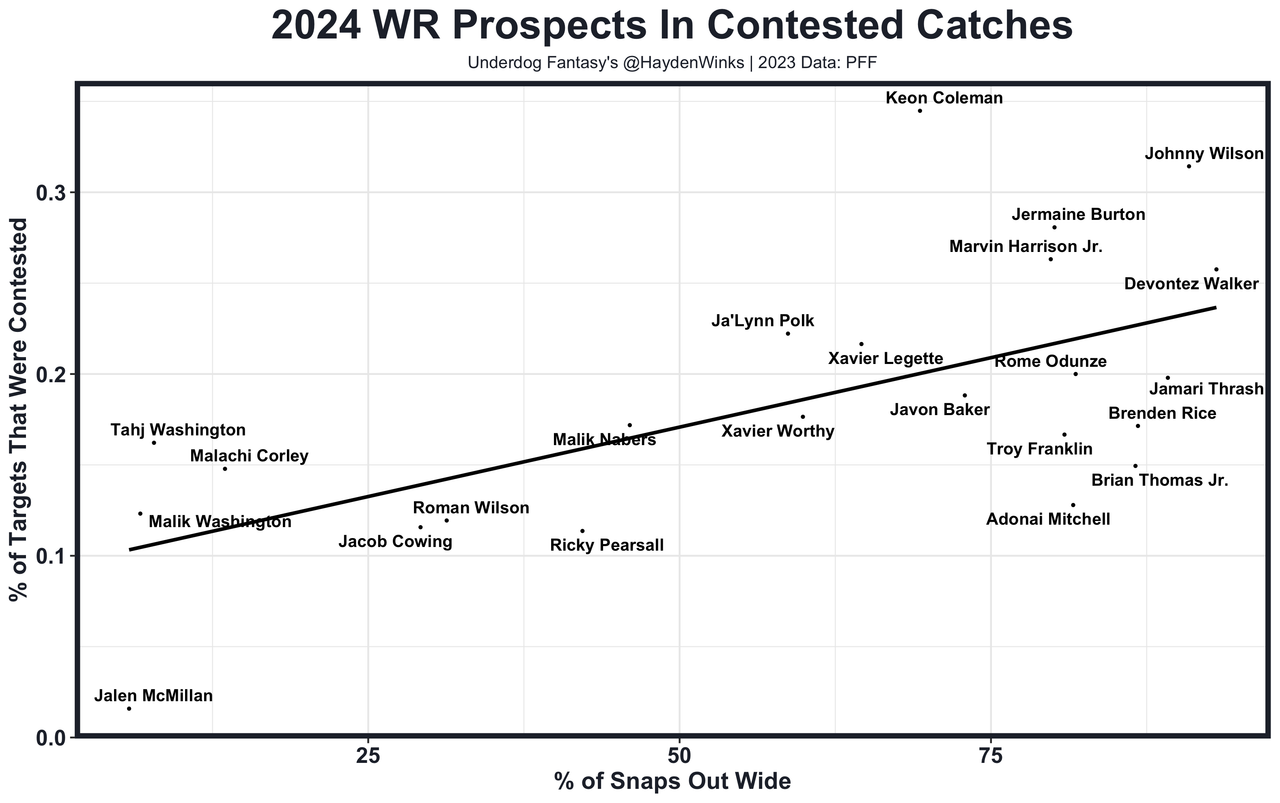
WR9 Xavier Legette (Round 2) - A QB in high school, Legette wasn't a WR starter until his 5th season at South Carolina, though he at least was a prolific kick returner while developing. It's a losing strategy to bet on super late declares like Legette, but he at least has the juice and size on tape. Legette was a yards after catch stud, was able to win on jump balls, and even flashed with some route running intermediate, particularly on digs and and curls. The Senior Bowl and NFL Combine will be big for him as he continues to climb draft boards. I liked his upside more than I did with Terrace Marshall, Jonathan Mingo, Cedric Tillman, and other boom-bust Round 2 types. The ceiling is intriguing, but he really needs to work on his ball tracking ability.
WR10 Roman Wilson (Round 2) - I wouldn't be surprised if Wilson goes earlier than expected despite a mediocre statistical profile in Michigan's run-first offense. Wilson is tough and athletic enough (4.41 forty) to be used in many ways, including with pre-snap in motion. With the Wolverines, Wilson was used in Amon-Ra St. Brown ways at a very similar size profile. There were some schemed up touches underneath, but Wilson can work the crosser and slot fade games as well. Hopefully he goes to an offensive coordinator that can use him like a chess piece because he's simply a good player. 78% of his catchable targets went for first downs in 2023. That's spicy.
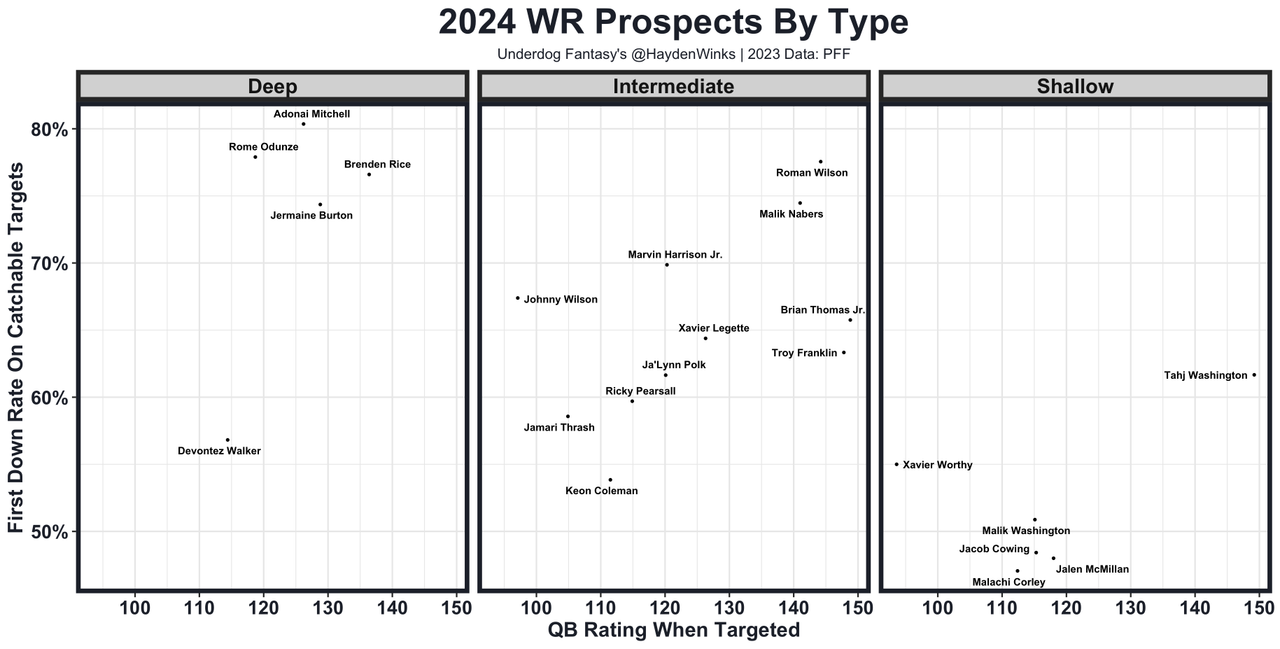
WR11 Troy Franklin (Round 2) - His slender frame (6'1"/176) is problematic, especially after testing as a 36th percentile adjusted SPARQ athlete. He plays faster than his 4.41 forty time, but Franklin rarely showed wiggle so his 30th percentile short shuttle wasn't a surprise. On tape, he's ideal for play action deep shots using go balls, posts, and deep crossers to utilize his difference-making straight line speed. Like others of this field-stretcher mold, Franklin had some untimely drops (10% per PFF), especially while working over the middle, but in general, he tracks the ball well over his shoulder and can use his length to his advantage. Expect him to struggle in the slant and in-breaking world because press defenders can play through him and he currently doesn't trust his hands. Ultimately, Franklin's elite production profile (3.3 yards per route run and 20.2 half PPR per game) and early declare status make him an intriguing second round selection, even if there are some limitations on tape. Some statistical comparisons include DeVonta Smith, Emmanuel Sanders, Jameson Williams, Jalin Hyatt, Darius Slayton, and Darnell Mooney.
WR12 Ricky Pearsall (Round 2) - He's an inside or outside undersized receiver that's truly silky smooth as a route runner. Pearsall can beat press coverage at the line of scrimmage and can work downfield because his tempo toys with defenders. There's just enough burst to have a chance at the next level, but the margins are thin because of his small frame. There's a chance a full-time pivot to the slot is on the table.
WR12 Ja'Lynn Polk (Late Round 2) - The sidekick to Odunze at Washington, Polk also won with physicality and solid route running. He didn't show an elite trait but can do a variety of things on the perimeter, including win on some jump balls and back shoulders. Polk is a Josh Palmer type in Round 2.
WR14 Jermaine Burton (Late Round 2) - There's speed to work with here. At Alabama, Burton worked as an outside deep threat (20.2 aDOT) featuring on go balls, posts, and sometimes on back shoulder fades. For a pure speedster, Burton has some lower-half size, allowing him to play through some contact. There weren't many YAC opportunities in the offense (few screens and accurate over-the-middle targets), but there's a chance there's more on the table in a more pass-heavy offense. He's a sleeper to me with a perfect drop rate in 2023 and a personality edge to him. That last part could be why he's getting little buzz, so don't be surprised if he's drafted after this grade.
WR15 Javon Baker (Early Round 3) - He committed to Alabama after receiving offers from everywhere, but Baker couldn't beat out John Metchie and Jameson Williams for playing time. Most can't! After transferring to UCF, he led his team in receiving in back-to-back years with a 33% yardage share as a senior. Baker ran real routes at X receiver against press man coverage and won constantly. He's physical at the catch point, but he created a ton of separation with both releases and bend at the break point. Baker can win contested, though he had a few downfield drops while playing out of control. In fact, two of his drops led to the funniest INTs you'll see, while his two biggest plays of the year were on complete busted coverages. In general, Baker has the traits of a standout NFL downfield threat.
WR16 Malachi Corley (Early Round 3) - The Deebo Samuel comparisons are real rich to me. Corley faced weak competition and ran a bunch of Mickey Mouse routes (5.5 aDOT and 3.8 air yards per catch), featuring whip routes, screens, and double moves. There are few NFL reps on his tape and I didn't see the Deebo yards after catch ability despite a few highlight truck sticks. I'd be surprised if he was a full-time player as a rookie, especially considering he was in the slot on 86% of his routes.
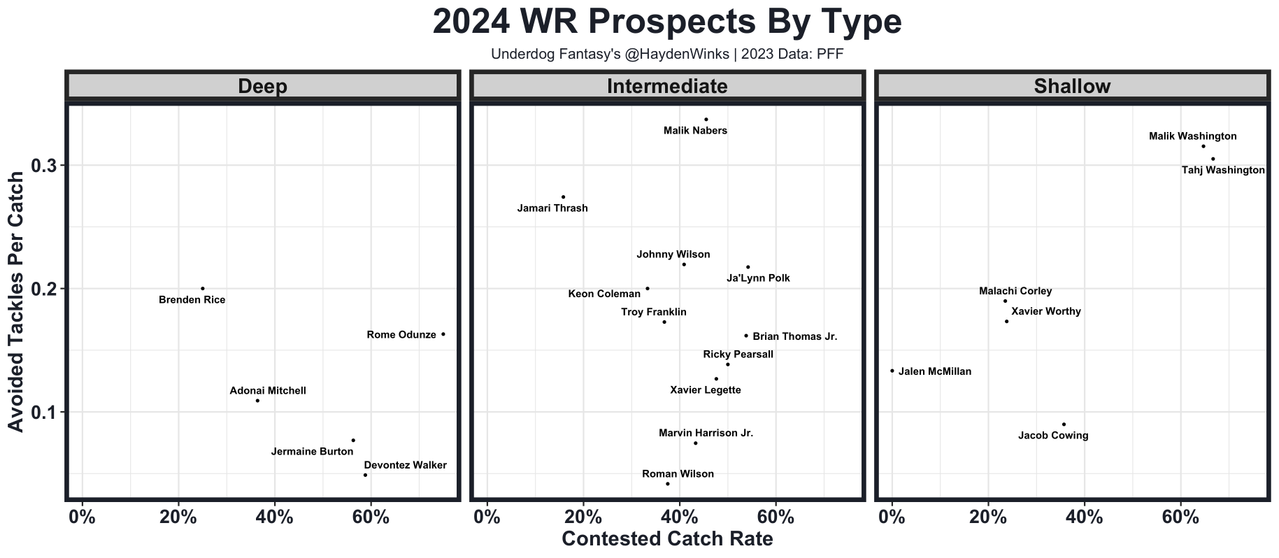
WR17 Devontez Walker (Round 3) - He's an Alec Pierce type who can primarily play on a straight line only. I was underwhelmed on my first watch of his because of his lack of bend and tendency to play into contact at the catch point. Walker had an absurd 18.2 aDOT, probably because he can't run underneath routes at a high level. His inconsistent play is worrisome because he faced a weak strength of schedule with a stud QB. The environment was ideal. The production wasn't.
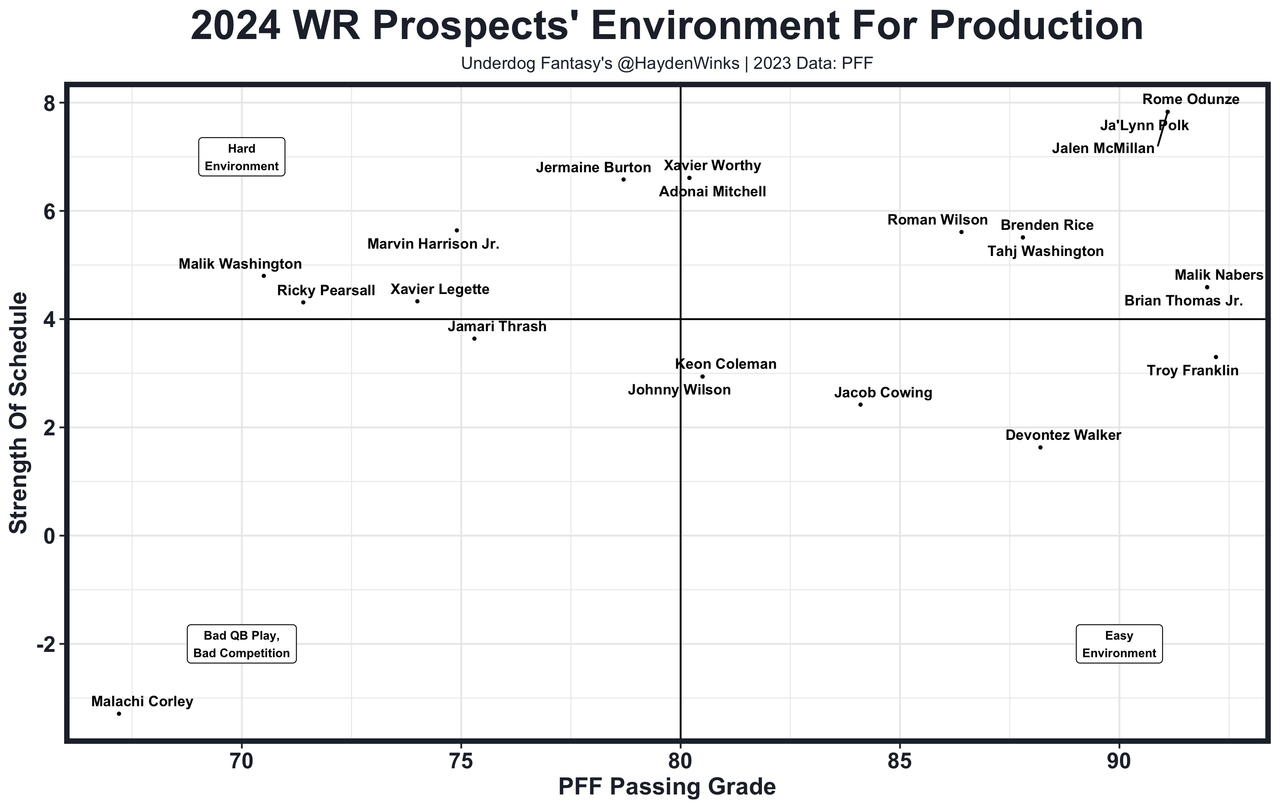
WR18 Tahj Washington (Round 3) - He's a vertical slot option out of USC with quality speed, ball tracking, and yards after the catch ability but a complete lack of size. Washington was stuffed in the screen game on occasion and likely can't be a full-time player in the NFL. He can be a nice rotational big play threat in 3-WR sets, however, because his speed and reliable hands are a fit in a spread style offense. Washington's efficiency metrics are high end (noting it helps to play with Caleb Williams).
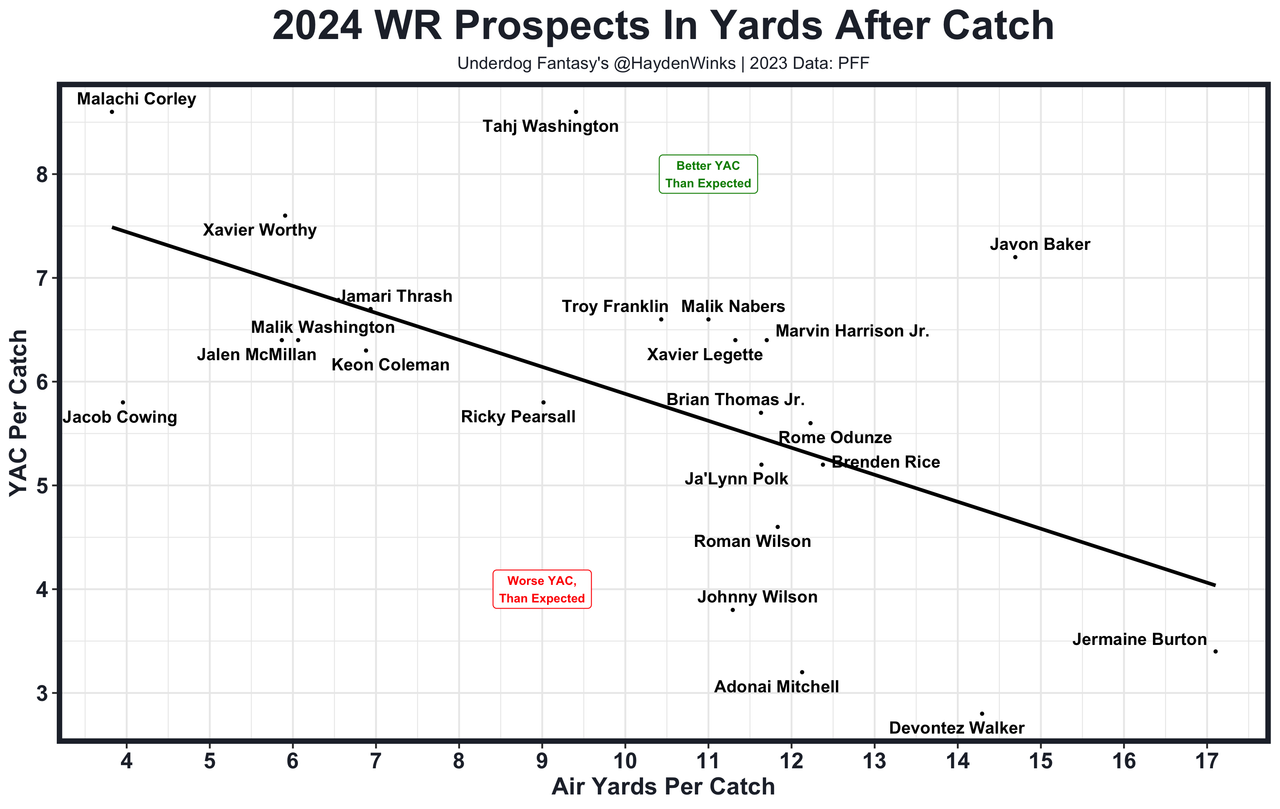
WR19 Malik Washington (Round 3) - It took him until his 5th year and a transfer out of Northwestern to Virginia to breakout, but Washington dominated touches more than anyone in the class. He was schemed up screens, sweeps, and option routes underneath. His compact frame allows him to bounce off defenders after the catch and fight through some contact at the catch point, but his lack of stride makes him one of the slowest receivers in the class in terms of long speed. Washington did have a few downfield reps including some out and ups against zone coverage, where he looked fairly smooth with reliable hands. He's Deebo Samuel on 0.67x speed. I mean that as a good and bad thing.
WR20 Jalen McMillan (Late Round 3) - A lot of his production was based on Washington's advantageous scheme, where McMillan played off motion or in bunched sets. He rarely faced man coverage out of the slot and had a career 19% contested catch rate. McMillan played out of control at times (leading to some drops), and he didn't have the quick lateral ability of the typical slot receiver. He's different in that he can work downfield, sometimes using double moves. He's a lesser version of Christian Kirk.
WR21 Brenden Rice (Late Round 3) - Yes, he's the son of Jerry Rice. No, he doesn't have the juice like him. Brenden invites contact because of a lack of separation due to below-average speed. He does have a nice catch radius with plenty of size, but he's just not a separator on film. His 4.50 forty surprised me.
WR22 Jamari Thrash (Early Round 5) - He ran real routes at Louisville, facing press man coverage often and having to work at intermediate depths from the outside (90% snaps out wide). Thrash doesn't have standout size or athleticism, however. His best route was a comeback where he can sink his hips. His mediocre speed hurt him on downfield routes. His slender build works against him on in-breaking routes, leading to some drops. It's possible Thrash looks better off the line of scrimmage, but he falls in the late breakout and 5th-year declare bucket after transferring from Georgia State to Louisville.
I need to watch Johnny Wilson.
RB1 Jonathan Brooks (Round 3) - He's a potential bellcow back with the straight-line explosiveness, soft hands, and pass protection ability to be a high snap player. Brooks had multiple big runs thanks to his impressive cutback vision and quality long speed. He's an upright runner who can stride out but can also be chopped down. His lateral ability and pad level are his biggest knocks, assuming his torn ACL rehab continues to look okay; Shrine Bowl director of football ops Eric Galko believes Brooks will be ready in time for his rookie season. He was used in the flats as a receiver with multiple one-handed grabs and can stay on the field in passing situations because of his very strong pass protection. Brooks can key onto blitzers and stick his shoulder in there. He could slide into Round 3 because of injury, but Brooks is a classic Round 2 RB prospect.
RB2 Trey Benson (Round 3) - He's built like an NFL running back with a massive lower half that generates a ton of burst for a 223-pounder. Benson didn't get the complete bellcow workload at Florida State, but he impressed whenever given opportunities. He had multiple 50 yard scores, some on runs to the perimeter, some on runs up the middle, and some catches in the screen game. Benson has more power (and power run experience) than most big-play RBs, giving him plenty of NFL upside even if it wasn't a staple in college. He was a liability in pass protection because of his blitz diagnosing and he had a few careless drops out in the route, but Benson is worth developing after averaging 6.1 YPC in the Power 5. His size-speed combination comes with a ceiling, similar to Kenneth Walker without the rare agility.
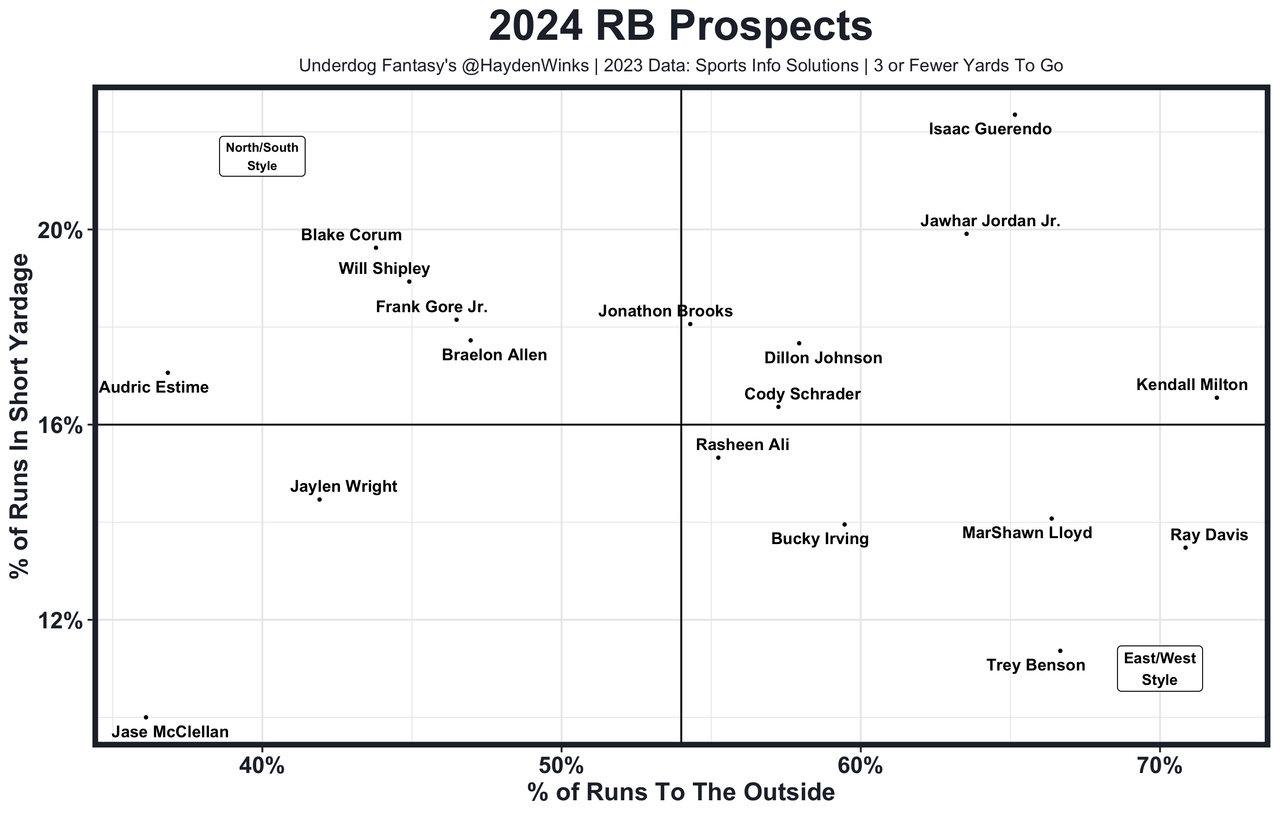
RB3 Marshawn Lloyd (Round 3) - Playing at both the fake (South Carolina) and real (Southern California) USCs, Lloyd operated as a violent downhill rusher in a primarily gap system out of shotgun. He can be patient, then burst up field before finishing runs with plenty of power. His size and speed are impressive, as his sweet cutting ability. He can get in trouble in two ways that'll require development to fix: fumbles and bouncing runs outside. Lloyd is a big play merchant in good and bad ways. He's inexperienced in pass protection with the size to hold up when asked to stay in, but Lloyd is probably destined for an early down role in the NFL. With better poise, Lloyd has starter ability.
RB4 Blake Corum (Early Round 4) - He benefited from a very strong scheme and offensive line at Michigan, scoring 27 touchdowns as a senior after a knee injury late in his junior season. Corum's long speed concerns (somewhat answered with a 4.53 forty) didn't hold him back as a short-yardage runner with a very low pad level (5'8"/205). He's not going to break too many tackles in the open field and can't break off the long run often, but Corum has great vision, experience, and quick feet (88th percentile agilities) in tight spaces to be a downhill compliment. His efficiency numbers are negatively impacted by running into boxes with 8+ defenders at the highest rate in college football (3.5 YPC on 109 attempts). He has similar size and athleticism as Devonta Freeman, Giovani Bernard, and Duke Johnson.
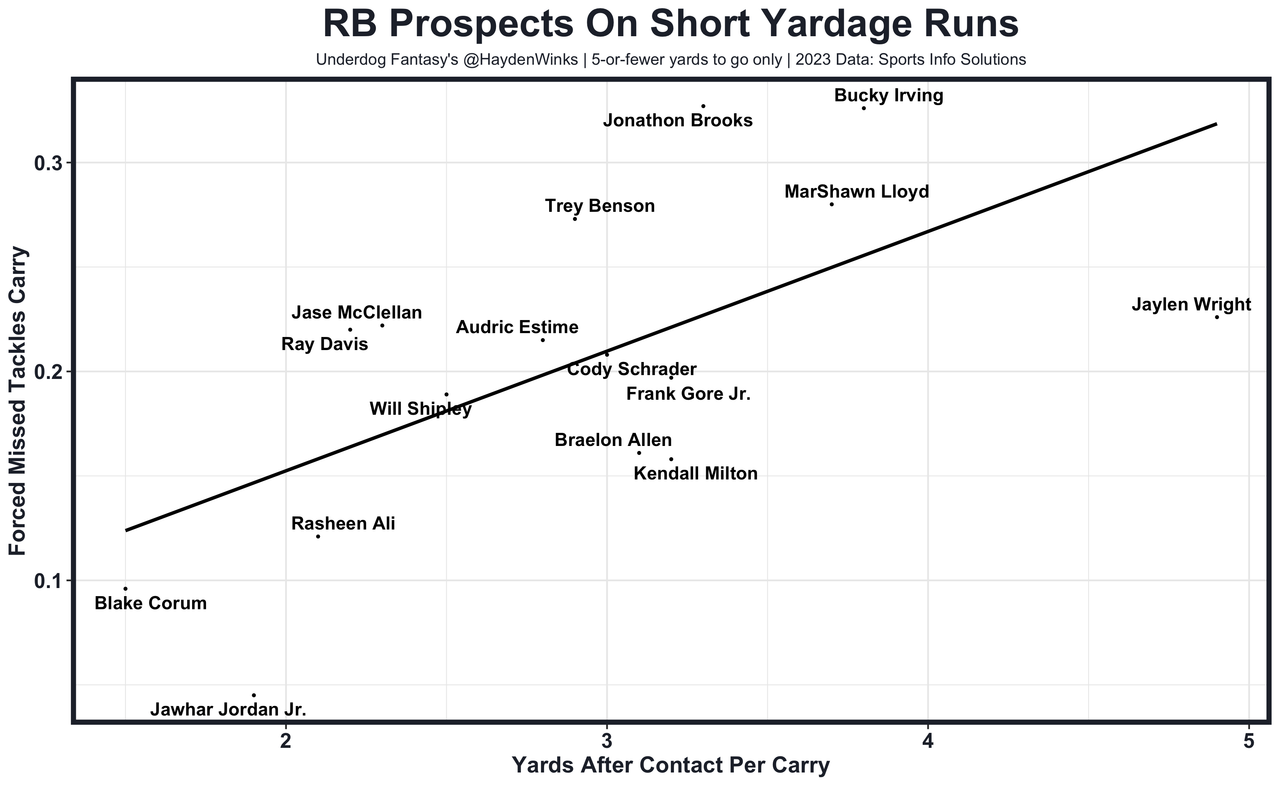
RB5 Jaylen Wright (Round 4) - He's like the Jalin Hyatt of this year's RB class because the Vols offense is so unique. Wright routinely faced light boxes yet ran up the middle against them, leading to multiple explosive runs (7.4 YPC). In fact, only 18% of his carries came with 7+ defenders in the box, compared to 26% with 5 or fewer. Insanity! On film, he plays with an upright style but can run past angles with ease. He has a decent jump cut in the open field, but Wright doesn't play with a lot of violence and can be indecisive with his vision. Even though most of his runs were up the middle based on Tennessee's scheme, Wright has the traits of an off-tackle runner with capabilities on passing downs. He caught plenty of quick-hitting swing passes against man-coverage LBs, saw a few screens as a WR, and was fine enough in pass protection. His traits excel best with space to work with, potentially limiting his overall volume in the NFL.
RB6 Audric Estime (Round 4) - Power. He had a lot of experience running under center at Notre Dame, and his skill set certainly matches it. Estime is a no non-sense player who finishes runs with a low pad level. After staying patient early on, he can maneuver in tight spaces with some high knees and bounce off contact with nice balance, making him a fine short-yardage option. There just might not be enough juice, open-space agility, or pass-game involvement to be more than that. The good news is power runs are swinging back in favor in the NFL (see: Kyren Williams). He's a lesser version of David Montgomery.
RB7 Braelon Allen (Round 4) - Drafting young, early declares (and Wisconsin RBs) has been a winning strategy, and Allen checks those boxes. He was an absolute workhorse in different styled offenses (power in 2021-22, then zone in 2023). His 238-pound frame suggests he's a downhill-only rusher, which he was before 2023, but Allen was put in shotgun on 99% of his junior season carries, many of which were pointed to the perimeter. In fact, his 121 carries attached to an RPO were 4th highest in college football per Sports Info Solutions. Allen has fantastic vision and power. He has just enough burst to get to the 2nd level, though he doesn't have the Derrick Henry long speed. Allen caught 28 passes but almost all were quick throws to the flats or tiny flicks within the backfield. It's not his strength. His biggest weakness (by far) is his pass protection. I truly couldn't believe how bad he was at it for a player of his size. Allen resembles A.J. Dillon in some ways, though I think Allen runs harder with better vision. The lateral ability was mediocre.
RB8 Ray Davis (Round 5) - He played at three programs (Temple, Vanderbilt, Kentucky), allowing him to establish a well-rounded skillset. Davis has a stocky, low-centered build that creates a powerful, downhill running style. He's not overly shifty, but he's a reliable runner who can hold his own on passing downs (33 super senior receptions). There wasn't a standout trait on my first watch.
RB9 Bucky Irving (Round 5) - We have another addition to Short King SZN, but Oregon did use him on power runs as their lead back. He has a versatile profile because he ran with a little more pop than what his size would indicate, but he doesn't have the shiftiness, burst, or speed of others in this role. Irving's value likely lies in the pass game, however, where he ran real routes. In fact, he led college football RBs in receptions, though he is a near zero in pass protection due to a lack of mass. Devin Singletary and Kyren Williams are the upside comps. That's not a great sign.
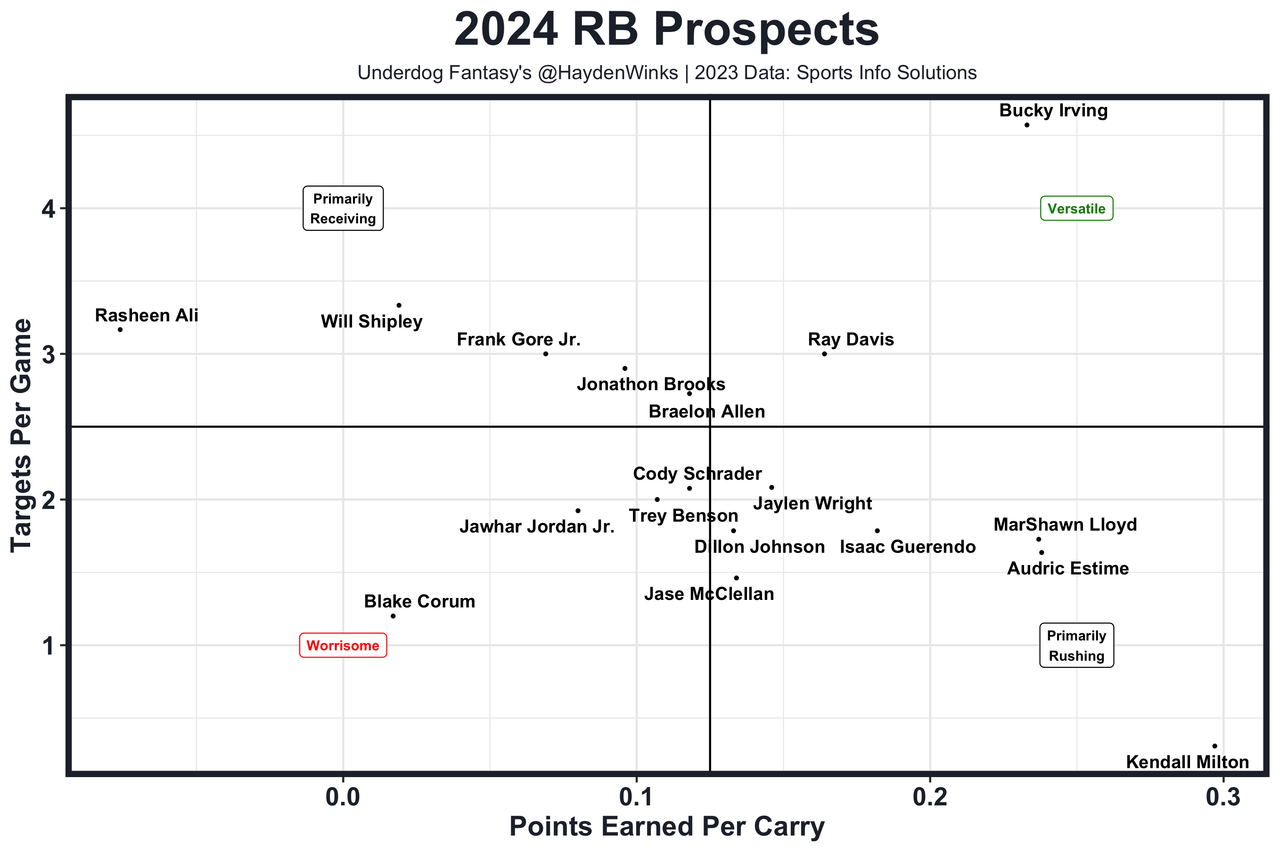
RB10 Kendall Milton (Round 5) - A 4-start recruit with offers from every national championship contender, Milton stayed patient at Georgia behind multiple NFL starters. His senior year was his most productive (14 TDs) but still only led to 121 carries and 4 receptions, partially because of a midseason knee injury. Milton has been stuck in an early-down committee role, which would be a massive con if he wasn't at Georgia. The good news is he led the class in EPA per carry, first down rate, and avoided "bust" runs according to Sports Info Solutions. Milton majored in runs to the perimeter (class-high 72% outside the tackle rate), often after pressing the hole to create more space on the outside. His burst and agility looked better before his injury, though his long speed was average at best throughout his career. He's completely inexperienced in the pass game and will have to pass medical tests before competing for carries. Milton is a one cut runner in the open field but has clean feet in tight spaces at the line of scrimmage. Hopefully he can run lower with more wiggle when healthier. In the meantime, his size and power are enough for fall forward yards. His 4.2 yards after contact were 2nd best in the class.
RB11 Dillon Johnson (Round 6) - He opened his collegiate career in Mississippi State's air raid offense, leading to 36, 65, and 58 reception seasons. His profile flipped at Washington, where he showcased a physical rushing style on 233 carries. Johnson's agility is below average, but he runs with low pad level at the contact point and can finish short-yardage runs well. His vision is his best trait. He can run with patience when needed but more importantly shows no hesitation on cutbacks, helping him earn a strong 52% rushing success rate as a senior. Johnson is comfortable with his hands and in pass protection, even if he's not a dynamic player in space. His 19% broken tackle rate is slightly below average in this class. Overall, Johnson's profile is similar to Kyren Williams, who would struggle in some roles and excel in others.
I need to watch RBs Isaac Guerendo and Jase McClellan.